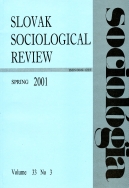From Dual Deviation to Dual Identity?
From Dual Deviation to Dual Identity?
Author(s): Monika ČambálikováSubject(s): Social Sciences
Published by: SAV - Slovenská akadémia vied - Sociologický ústav
Keywords: Deviation; identity; industrial relations; labour market; social partnership
Summary/Abstract: From Dual Deviation to Dual Identity? The Case of Electronic Industry Workers in Slovak Republic 1995 - 2000. The merit of this paper is the characteristic of working life and industrial relations in the electronic industry in Slovak Republic based on the comparison of selected outcomes obtained in the framework of 2nd (year 1995) and 3rd (year 2000) phase of international research "Quality of Working Life in the Electronic Industry" . The main research tool was a survey of workers attitudes, using a standardised questionnaire, together with the economic analyses and interviews with experts. The selected research outcomes are provided in the context of economic and social development, situation on the labour market and the development of industrial relations and relations of social partnership in Slovakia during the observed period. The most important change in industrial relations in Slovakia (at least in observed firms) in the last five years was the following: while in 1995 there was a typical tendency to dual deviation (workers-identification neither with management nor with trade union) in the sphere of industrial relations in the Slovak electronic industry, in 2000 dual identity (workers identification with management and simultaneously with trade union) predominated. The characteristic of Slovak economy, its branches and also surveyed plants is important dimension for explanation of this changes such as for consideration of question whether the dual identity in contemporary Slovakia - including the reasons of its creation - is specific in comparison with universal trends, observed in West European countries. Sociológia 2001 Vol 33 (No. 3: 235-250)
Journal: Sociológia - Slovak Sociological Review
- Issue Year: 2001
- Issue No: 3
- Page Range: 235-250
- Page Count: 16
- Language: English

